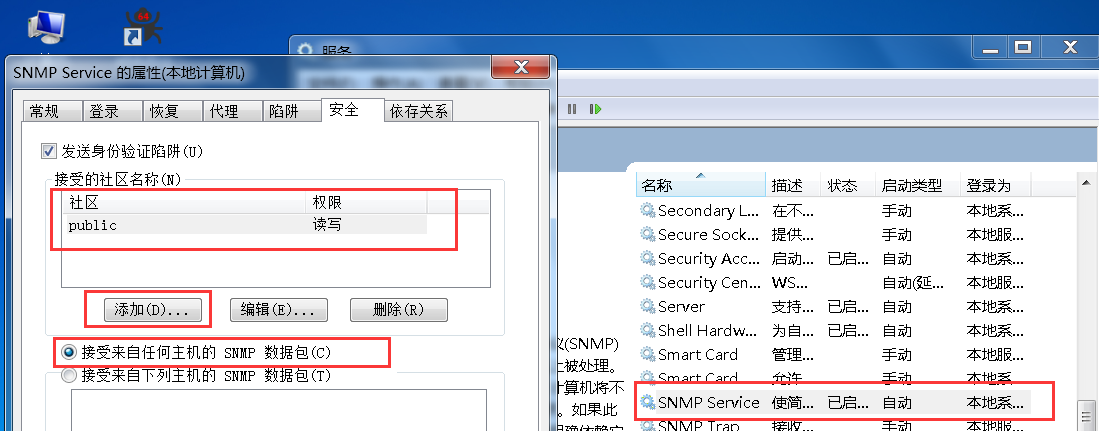? 优质资源分享 ?
| 学习路线指引(点击解锁) | 知识定位 | 人群定位 |
|---|---|---|
| ? Python实战微信订餐小程序 ? | 进阶级 | 本课程是python flask+微信小程序的完美结合,从项目搭建到腾讯云部署上线,打造一个全栈订餐系统。 |
| ?Python量化交易实战? | 入门级 | 手把手带你打造一个易扩展、更安全、效率更高的量化交易系统 |
PySNMP 是一个纯粹用Python实现的SNMP,用PySNMP的最抽象的API为One-line Applications,其中有两类API:同步的和非同步的,都在模块pysnmp.entity.rfc3413.oneliner.cmdgen 中实现,如下是Get方式与Walk方式的基本实现.
首先需要在系统中安装SNMP客户端,对于Linux平台来说只需要执行如下配置过程即可.
[root@localhost ~]# yum install -y net-snmp
[root@localhost ~]# cat /etc/snmp/snmpd.conf |grep -vE "^#|^$"
com2sec notConfigUser default public
group notConfigGroup v1 notConfigUser
group notConfigGroup v2c notConfigUser
view systemview included .1
view systemview included .1
access notConfigGroup "" any noauth exact systemview none none
[root@localhost ~]# systemctl restart snmpd
[root@localhost ~]# systemctl enable snmpd
如果是Windows系统则需要在客户机服务列表,开启SNMP支持,并设置好一个团体名称,如下图。

当我们配置好客户端后,服务端就客户获取数据了,我们以一个OID序号为例,我们查询特定序号对应的名称,然后将其记录下来,例如下面这样。
C:\Users\admin> snmpwalk -v 2c -c public 192.168.1.101 .1.3.6.1.2.1.25.2.2
HOST-RESOURCES-MIB::hrMemorySize.0 = INTEGER: 2096632 KBytes
首先我们不使用PySNMP模块直接开线程调用看看,该代码如下所示.
import os,re,time
# 通过SNMP收集主机CPU利用率: 通过SNMP协议,收集目标主机的CPU利用率(百分比),并返回JSON字符串.
def Get\_CPU\_Info(addr):
try:
Head = ["HostName","CoreLoad","CpuUser","CpuSystem","CpuIdle"]
CPU = []
ret = os.popen("snmpwalk -v 2c -c nmap " + addr + " .1.3.6.1.2.1.1.5")
CPU.append(ret.read().split(":")[3].strip())
ret = os.popen("snmpwalk -v 2c -c nmap " + addr + " .1.3.6.1.2.1.25.3.3.1.2")
CPU.append(ret.read().split(":")[3].strip())
for i in [9,10,11]:
ret = os.popen("snmpwalk -v 2c -c nmap " + addr + " 1.3.6.1.4.1.2021.11.{}.0".format(i))
ret = ret.read()
Info = ret.split(":")[3].strip()
CPU.append(Info)
return dict(zip(Head,CPU))
except Exception:
return 0
# 通过SNMP获取系统CPU负载信息: 分别获取到系统的1,5,15分钟的负载信息,并返回JSON格式.
def Get\_Load\_Info(addr):
try:
Head = ["HostName","Load1","Load5","Load15"]
SysLoad = []
ret = os.popen("snmpwalk -v 2c -c nmap " + addr + " .1.3.6.1.2.1.1.5")
SysLoad.append(ret.read().split(":")[3].strip())
ret = os.popen("snmpwalk -v 2c -c nmap " + addr + " .1.3.6.1.4.1.2021.10.1.3")
load = list(re.sub(".*STRING: ", "", ret.read()).split("\n"))
SysLoad.append(load[0])
SysLoad.append(load[1])
SysLoad.append(load[2])
return dict(zip(Head,SysLoad))
except Exception:
return 0
# 通过SNMP获取系统内存占用: 内存利用率,获取到之后,将其转化为字典格式保存。
def Get\_Mem\_Info(addr):
try:
Head = ["HostName","memTotalSwap","memAvailSwap","memTotalReal","memTotalFree"]
SysMem = []
ret = os.popen("snmpwalk -v 2c -c nmap " + addr + " .1.3.6.1.2.1.1.5")
SysMem.append(ret.read().split(":")[3].strip())
ret = os.popen("snmpwalk -v 2c -c nmap " + addr + " .1.3.6.1.4.1.2021.4")
mem = ret.read().split("\n")
for i in [2,3,4,6]:
SysMem.append(re.sub(".*INTEGER: ","",mem[i]).split(" ")[0])
return dict(zip(Head,SysMem))
except Exception:
return 0
# 通过SNMP获取系统磁盘数据: 这个案例并不完整,我只写了一点,后面有个问题一直没有解决.
def Get\_Disk\_Info(addr):
try:
dic = {}
list = []
ret = os.popen("snmpwalk -v 2c -c nmap " + addr + " HOST-RESOURCES-MIB::hrStorageDescr")
DiskName = ret.read().split("\n")
ret =os.popen("snmpwalk -v 2c -c nmap " + addr + " HOST-RESOURCES-MIB::hrStorageUsed")
DiskUsed = ret.read().split("\n")
ret = os.popen("snmpwalk -v 2c -c nmap " + addr + " HOST-RESOURCES-MIB::hrStorageSize")
DiskSize = ret.read().split("\n")
for i in range(1,len(DiskName) - 7):
dic["Name"]= DiskName[i + 5].split(":")[3]
dic["Used"]= DiskUsed[i + 5].split(":")[3]
dic["Size"]= DiskSize[i + 5].split(":")[3]
list.append(dic)
return list
except Exception:
return 0
if __name__ == '\_\_main\_\_':
for i in range(100):
dic = Get_CPU_Info("192.168.1.20")
print(dic)
time.sleep(1)
折叠 我们使用pysnmp模块来做,安装pysnmp很简单,执行命令pip install pysnmp 即可,安装后使用以下代码执行即可获取到目标数据,获取方式分为两种一种为Get另一种为Walk.
from pysnmp.hlapi import *
import os,sys
class NetSNMP():
def \_\_init\_\_(self,address,region):
self.region = region
self.address = address
# 获取指定数据的方法
def GetNumber(self,oid,sub_oid,sub_id):
iterator = getCmd(SnmpEngine(),
CommunityData(self.region),
UdpTransportTarget((self.address, 161)),
ContextData(),
ObjectType(ObjectIdentity(oid, sub_oid, sub_id)))
errorIndication, errorStatus, errorIndex, varBinds = next(iterator)
if errorIndication:
return False
else:
if errorStatus:
return False
else:
for varBind in varBinds:
return [x.prettyPrint() for x in varBind]
# 使用Walk拉取数据
def WalkNumber(self, oid):
res = []
for (errorIndication, errorStatus, errorIndex, varBinds) in nextCmd(SnmpEngine(),
CommunityData(self.region),UdpTransportTarget((self.address, 161)),ContextData(),
ObjectType(ObjectIdentity(oid)).addMibSource(
'./site-packages/pysnmp/smi/mibs','pysnmp\_mibs'),lexicographicMode=False):
if errorIndication:
print(errorIndication, file=sys.stderr)
break
elif errorStatus:
print('%s at %s' % (errorStatus.prettyPrint(),
errorIndex and varBinds[int(errorIndex) - 1][0] or '?'),
file=sys.stderr)
break
else:
for varBind in varBinds:
res.append(str(varBind))
return res
if __name__ == "\_\_main\_\_":
# 初始化
ptr = NetSNMP("192.168.81.130","public")
# 使用GET方式获取OID数据
ret = ptr.GetNumber("HOST-RESOURCES-MIB","hrMemorySize",0)
print("类型: {} --> 返回结果: {} --> 解析: {}".format(type(ret),ret,ret[1]))
# 使用Walk方式获取OID数据
ret = ptr.WalkNumber(".1.3.6.1.2.1.2.2.1.6")
for each in ret:
mac = each.split("=")[1]
if len(mac) > 1:
print("网卡接口: {}".format(mac))
折叠 转载请注明:xuhss » Python 封装SNMP调用接口